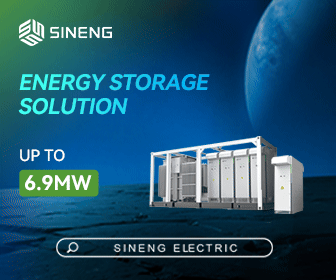Why Refrigerated Warehouses Need Long-Duration Thermal Energy Storage
Managing the ever-increasing demand on our aging electrical grid is becoming more complex with the added imperative of reducing emissions. The Biden Administration's bold $36 billion decarbonization plan includes goals to improve the power grid's infrastructure to help grid operators around the U.S. address these twin challenges.

To tackle climate change holistically and understand how to effectively improve the grid, the building industry - which accounts for about 76 percent of electricity use and 40 percent of all U. S. primary energy use and associated greenhouse gas (GHG) emissions - must be examined for improvement opportunities. One sector that tends to be overlooked is refrigerated commercial and industrial (C&I) warehouses. The many thousands of cold storage warehouses throughout the cold chain have the highest energy demand per cubic foot, and are the third-highest-consuming category due to their temperature requirements and associated refrigeration needs. With the proper energy technologies, these facilities can deliver dramatic performance improvements to the grid, while reducing GHG emissions and costs for both grid operators and facility owners.
Through investments in Distributed Energy Resources like renewables, energy storage, and efficiency technologies, the U.S. can generate and store cleaner electricity where and when it's needed, while helping the grid manage demand. Long-duration energy storage solutions, in particular, are in greater demand and expected to play a significant and growing role in the global energy transition.
 Shedding Light on the C&I Industry
Shedding Light on the C&I Industry
The U.S. cold storage sector is set to grow at a compound annual rate of 4.5 percent by 2023, as the necessity for additional cold storage space becomes more pronounced. The cold chain spends over $40 billion on electricity annually - refrigeration energy can account for up to 70 percent of its total electric costs. In addition, the average age of U.S.-based warehouses is 35 years, making them prime properties for technology and energy improvements.
These warehouses store temperature-controlled foods as they move through the cold chain to grocery retailers, convenience stores, and restaurants. In order to maintain food quality and shelf life as goods travel along the cold chain to our plates, these low-temperature facilities must maintain extremely low and stable temperatures that typically range from -20 to 0 degrees Fahrenheit. Maintaining such temperatures during each leg of that journey requires refrigeration equipment to run nearly 24/7, resulting in high energy demand around the clock. This high level of demand puts extreme strain on the power grid every day, especially during peak periods.
A Clear, Sustainable Solution
To reduce energy use and achieve a cleaner energy future, it is critical that C&I refrigerated warehouses integrate digital and energy storage technologies. Long-duration Thermal Energy Storage (TES) technology is a utility-tested, proven, and incentivized option to help these facilities cut costs and GHG emissions, while also reducing strain on the grid with many forms of demand flexibility.
TES technology sits behind the meter, uses the client's existing refrigeration equipment, has no mechanical components, and leverages the heat transference properties of phase change material through intelligent controls to reduce energy consumption and manage demand, while better maintaining stable freezer temperatures. This happens because the TES systems allow energy-intensive refrigeration equipment to be staged down for long periods of time to provide added flexibility and capacity to the grid. For example, refrigeration systems can be cycled down during peak demand hours or at times when renewable energy sources go offline, discharging cooling energy for up to 13 hours.
 Another benefit of implementing TES into C&I refrigerated facilities is that these systems leverage advanced digital technology that makes real-time decisions to best optimize temperatures and energy use, delivers 24/7 monitoring of temperatures, equipment, and energy use, and sends notifications of irregular equipment or temperature status. This level of visibility and control is critical for warehouses looking to modernize, and can help pinpoint additional areas of potential improvement. It also provides facilities with the assurance that optimal temperatures are being kept, while cooling demand is minimized at times when it can be most beneficial to the grid and the environment.
Another benefit of implementing TES into C&I refrigerated facilities is that these systems leverage advanced digital technology that makes real-time decisions to best optimize temperatures and energy use, delivers 24/7 monitoring of temperatures, equipment, and energy use, and sends notifications of irregular equipment or temperature status. This level of visibility and control is critical for warehouses looking to modernize, and can help pinpoint additional areas of potential improvement. It also provides facilities with the assurance that optimal temperatures are being kept, while cooling demand is minimized at times when it can be most beneficial to the grid and the environment.
TES technology improves refrigeration efficiency by an average of 25 percent, and reduces energy costs up to 50 percent in some cases. It provides extended load shedding, peak-demand reduction, demand response capability, and other critical demand management needs. Companies taking advantage of this technology have avoided more than 23 million kWh and 17,000 MT of GHG emissions. If the entire refrigerated C&I sector implemented thermal energy storage, it would be an impactful leap towards a more carbon neutral cold chain.
A Step Forward for the Energy Transition
One of the most critical steps toward achieving a successful global energy transformation is identifying the most energy-intensive sectors and prioritizing cleaner, more energy-efficient technology to help solve the power grid puzzle. As U.S. Energy Secretary Jennifer Granholm said, "The U.S. needs to deploy massive amounts of renewable energy capacity in the next four years."
With renewables comes a greater need for energy storage, and TES pairs perfectly with onsite or grid-scale renewables. It provides utilities with safe access and visibility to the cold storage industry, as well as a way to mitigate its enormous demand for grid capacity. This newly added flexibility can help utilities delay or avoid costly infrastructure projects and provides a path to engagement with C&I customers.
To achieve the Biden Administration's goal of 100 percent carbon-free energy by 2035 in the U.S., TES will need to play a role to help facilitate the energy transition and position the power grid for a cleaner, more sustainable future.
The cold storage industry is growing rapidly; it's time to bring attention to how sustainable technologies specific to this segment can play a role in reducing its energy footprint.
Damon Vance is the Director of Marketing for Viking Cold Solutions, a thermal energy storage and energy optimization provider for the refrigerated cold storage and food industries.
Viking Cold Solutions | www.vikingcold.com
Author: Damon Vance
Volume: 2021 July/August









